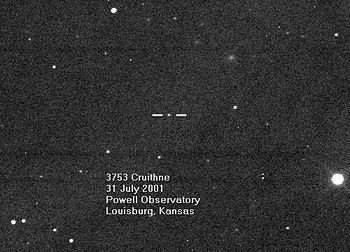3753 Cruithne
 |
|
| Discovery | |
|---|---|
| Discovered by | Duncan Waldron |
| Discovery date | 10 October 1986 |
| Designations | |
|
Named after
|
Cruthin |
| 1983 UH; 1986 TO | |
|
Aten asteroid, bean-shaped horseshoe orbit Near-Earth asteroid, Venus-crosser asteroid, Mars-crosser asteroid |
|
| Orbital characteristics | |
| Epoch 13 January 2016 (JD 2457400.5) | |
| Uncertainty parameter 0 | |
| Observation arc | 15334 days (41.98 yr) |
| Aphelion | 1.5114 AU (226.10 Gm) |
| Perihelion | 0.48398 AU (72.402 Gm) |
| 0.99771 AU (149.255 Gm) | |
| Eccentricity | 0.51491 (1600000 wrt Earth) |
| 1.00 yr (364.00 d) | |
|
Average orbital speed
|
27.73 km/s |
| 24.067° | |
| 0° 59m 20.436s / day | |
| Inclination | 19.807° |
| 126.24° | |
| 43.817° | |
| Earth MOID | 0.0705223 AU (10.54999 Gm) |
| Jupiter MOID | 3.51635 AU (526.038 Gm) |
| Jupiter Tisserand parameter | 5.922 |
| Physical characteristics | |
| Dimensions | ~5 km |
| 27.30990 h (1.137913 d) | |
| 15.6 | |
3753 Cruithne (/kruːˈiːnjə/ or /ˈkrʊnjə/) is a Q-type, Aten asteroid in orbit around the Sun in 1:1 orbital resonance with Earth, making it a co-orbital object. It is an asteroid that, relative to Earth, orbits the Sun in a bean-shaped orbit that effectively describes a horseshoe, and that can transition into a quasi-satellite orbit. It has been incorrectly called "Earth's second moon". Cruithne does not orbit Earth and at times it is on the other side of the Sun, placing Cruithne well outside of Earth's hill sphere. Its orbit takes it inside the orbit of Mercury and outside the orbit of Mars. Cruithne orbits the Sun in about 1 year but it takes 770 years for the series to complete a horseshoe-shaped movement around the Earth.
The name Cruithne is from Old Irish and refers to the early Picts (Irish: Cruthin) in the Annals of Ulster and their eponymous king ("Cruidne, son of Cinge") in the Pictish Chronicle.
...
Wikipedia
